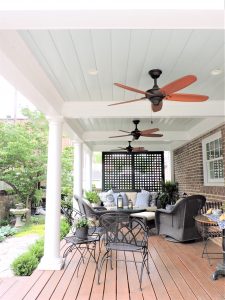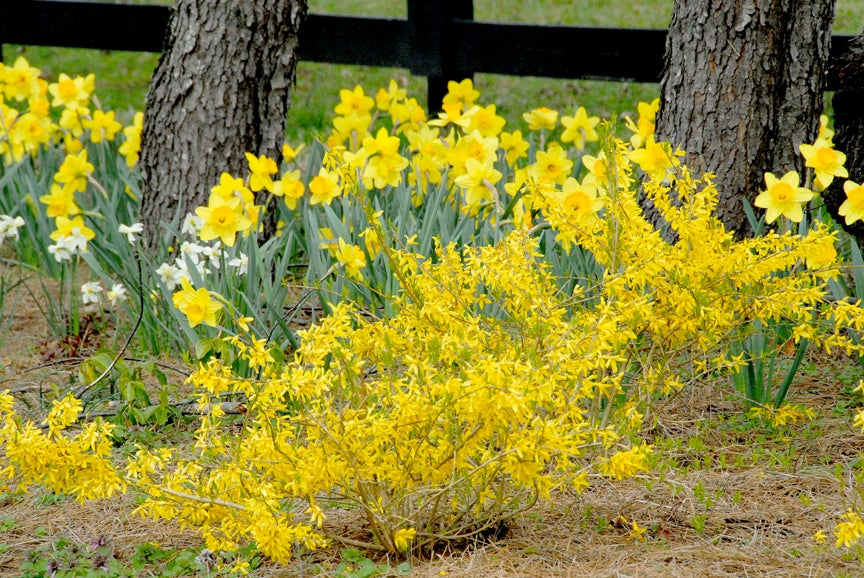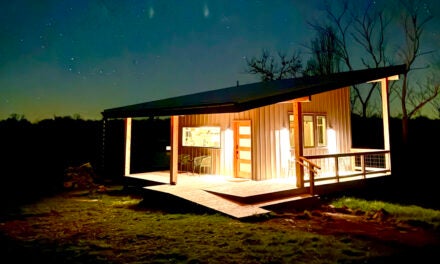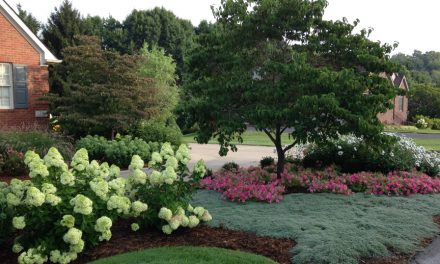As soon as the weather turns warm, my husband and I make a bee-line for the screened porch. Whether the weather is warm or slightly cool, dry or a bit rainy, we treasure time on the porch. It’s the place for coffee in the morning and simple dinners in the evening. When company arrives, our porch becomes a favorite gathering spot. The seating is comfortable, the beverages are cold, and the scenery is well planned. It works because our outdoor room was designed as if it were any other room of the house.

The back porch of Judith and Jim Thornton is perfect protected outdoor living area. The cozy conversation arrangement with a mix of furnishings and the adjacent bistro table create a relaxing environment. The extended site lines includes walking paths, fountains, and outdoor fireplace area. The light sky blue porch ceiling treatment serves is a favorite southern porch ceiling treatment. (Photo courtesy Terri Bennett)
After months of winter weather, the interior walls of a house can start to feel like a shoe box. And a box with four walls and a ceiling tends to bind occupants inside. Warm summer months allow for the extension of living spaces into the outdoors. Because outdoor areas are used the same way as indoor spaces, it’s important to plan them as you would an interior space. The plan doesn’t have to be expensive or elaborate, but it does need to incorporate good design.
It begins with the inside/outside parallels of any room — the frame, a defined function and layered amenities. To make it work, it’s all about design. Following the rules of basic design, such as scale, color, form and function (a cooking area, conversation area or solitary reading place) virtually guarantees success. With the addition of beautiful landscaping, outdoor living areas become an irresistible destination.
- Create parameters. A structure overhead, even if it is merely an open pergola, creates the parameters of the outdoor “room.” It provides a sense of shelter and security. Simple umbrellas or shade sails can be a cost effective way to add the effect of a ceiling that allows the occupant to feel at home. A canopy of nearby trees can work with almost no effort. Posts, poles and tree trunks form vertical framing, much the way interiors walls work with the added benefit of a view beyond.
- Personality. Designing outdoor living rooms should represent a relaxed extension of the style of your home. Because outdoor spaces are typically more casual and relaxed, eclectic furnishings and accessories choices work best. It’s also a place to interject a sense of humor where it might normally be out of place. What better place is there to show a happy, relaxed — you.
- Texture. Natural elements present in all outdoor spaces create easy texture. Continue to add texture through the use of metals, woods, stone and florals in material finishes, furnishings and accessories. There is no hesitation needed in mixing natural materials. Use the beauty of nature to influence and guide the design.
- Comfort. Outdoor living spaces should be as inviting as interior spaces. Build in a place to dine and a place to gather, but also incorporate comfort. The obvious way to add comfort is through use of upholstered furnishings, but it is not the only way. Shade from harsh rays of the sun, the visual softness of small blooming plants and cool grass underfoot, all figure into the overall comfort of a space.
- Appeal to the senses. Outdoor spaces are appealing because they engage all five senses. Near and far sites lines become interesting visuals. The clean fragrance of grass and fresh air, combined with floral blooms awaken scent factors. Listening to chirping birds and buzzing bees becomes a relaxing ritual. Touch the flower petals and feel the ease of the chair cushion. And, let’s not forget the taste of a simple meal in the outdoors — smoky burgers, juicy corn on the cob, a crisp salad — and watermelon!
Terri Bennett is the owner of Terri Bennett Interior Design.









